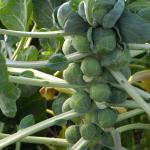Growing Brussels sprouts
Brassica sp. : Brassicaceae / the mustard or cabbage family
| Jan | Feb | Mar | Apr | May | Jun | Jul | Aug | Sep | Oct | Nov | Dec |
|---|---|---|---|---|---|---|---|---|---|---|---|
| S | |||||||||||
| T | |||||||||||
| P |
(Best months for growing Brussels sprouts in USA - Zone 5a regions)
- S = Plant undercover in seed trays
- T = Plant out (transplant) seedlings
- P = Sow seed
- Grow in seed trays, and plant out in 4-6 weeks. Sow seed at a depth approximately three times the diameter of the seed. Best planted at soil temperatures between 45°F and 86°F.
- Space plants: 18 - 24 inches apart
- Harvest in 14-28 weeks. Pick sprouts when small. .
- Compatible with (can grow beside): Dwarf (bush) beans, beets, celery, cucumber, onions, marigold, nasturtium, rhubarb, aromatic herbs (sage, dill, chamomile)
- Avoid growing close to: Climbing (pole) beans, tomato, peppers (chili, capsicum), eggplant (aubergine), strawberry, mustard
Grown for its small (typically 2.5 cm diameter) leafy green buds, which resemble miniature cabbages.
Suited to growing in cooler climates.
Brussel Sprouts will not grow good "sprouts" in warm areas - they open and are floppy.
In warm areas they are likely to become infested with aphids. Pick formed sprouts from the bottom of the stems leaving the plant growing. For winter use in very cold areas, dig up plants that have heads developed and set close together in a cold frame or cellar. Pack soil firmly round the roots. Keep cool but not freezing and they will continue to mature. (Planning an Idaho Vegetable Garden: Educational Communication online Publishing Catalog Gardening www. cals.uidaho.edu/ edComm/catalog.asp.)
Culinary hints - cooking and eating Brussels sprouts
Remove any discoloured outer leaves.
Cut in half and steam with other vegetables.
Do not overcook as that produces the distinctive smell that puts people off eating Brussels sprouts!
They go well with a chopped tomato and onion mix.
Traditionally served with roasted chestnuts for Xmas dinner in UK.



Your comments and tips